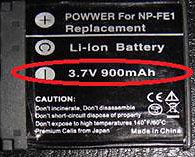Planning on making a trip by air anytime soon? If so, then you need to know about the limitations air passengers are now subject to when traveling with devices powered by or containing lithium batteries or when carrying spare batteries. These changes cover a wide range of articles, ranging from personal electronic devices (PEDs); spare batteries; power banks/external chargers; e-cigarettes and ?smart baggage.?

Lithium batteries are widely used in consumer electronic devices because they are rechargeable. However, these batteries may pose a hazard ? not only when transported by air, but also while in use at home. These batteries can generate dangerous levels of heat, become a source of ignition, short circuit easily and the fires they generate are not easily extinguished.
So what exactly is a lithium battery? There are generally two types of lithium batteries in use ? lithium ion and lithium metal batteries. The main difference between the two is that lithium-ion batteries are rechargeable, but lithium metal batteries are not. Common examples of lithium-ion batteries include laptop/tablet batteries, phone batteries and rechargeable camera batteries. Some common examples of lithium metal batteries include watch batteries and some non-rechargeable camera batteries.
Specific limitations placed on passengers PEDs are defined as equipment that uses lithium batteries as a power source. This includes, but is not limited to, medical devices such as portable oxygen generators and consumer electronics like cameras, mobile phones, laptops and e-readers.
Here are the passenger guidelines: ? Each passenger cannot bring more than 15 PEDs on board a plane, whether in carry-on or checked baggage. ? Each installed battery in a PED must not exceed the following: ? For lithium-ion batteries, a watt hour rating of not more than 100 Wh (watt hours) ? For lithium metal or lithium alloy batteries, a lithium content of no more than two grams ? Air regulations recommended that these devices be carried in carry-on baggage ? If they are carried in checked baggage, measures must be taken to protect the devices from damage and prevent unintentional activation ? The devices must be completely switched off (not in sleep or hibernation mode)
How do I find the watt hour rating of my lithium-ion battery? By the end of 2015, all new lithium-ion batteries were required to be marked with their watt hour ratings and most batteries will identify their type. If by chance you have a battery manufactured prior to the end of 2015, it may only be marked with Ampere hours (Ah) or mAmpere hours (mAh) and Voltage (V). If that is the case, a simple calculation can determine the Wh rating of the battery.

In the example shown on the left, the battery is marked with the Wh rating of 8.5 (well below the 100 Wh limit). If you look closely, you will also see it is marked Li-ion.
If your battery does not list a Wh rating, you will need to use the following calculation: (Volts x ampere hour (Ah) = watt hours) to determine the Wh rating. The battery to the right is clearly identified as a lithium-ion battery and does not show a Wh rating, but it does show it is rated at 3.7 volts (V) and 900 milliampere hours(mAh).

If the capacity of your battery is expressed in milliampere hours (mAh) ? like in this example ? you will need to divide by 1,000 to calculate the ampere-hours (Ah) before multiplying (900 mAh/1,000 = 0.9 Ah). So, the calculation would be 3.7 V x 0.9 Ah = 3.33 Wh (again, well below the 100 Wh rating limit).
Traveling with spare batteries If you absolutely need to bring spare batteries with you, they must be transported in carry-on luggage and each battery must be protected to prevent short circuits. You can accomplish this by keeping them in their original packaging, taping over the exposed terminals or individually wrapping them in bags. Most airlines have a limit on how many spare batteries you can bring so check with your airline first.
Power banks and external chargers Any device intended to provide power to another device and contains a lithium-ion or metal battery should be handled the same way as spare batteries mentioned above.
Vape pens and electronic cigarettes Electronic cigarettes containing lithium batteries are permitted in carry-on luggage by most airlines, but vape pens are still considered hazardous cargo. Confirm with your airline in advance in case their procedures and rules vary.
Smart luggage Many suitcases are now coming equipped with the capability to power your laptop or phone. Some you can even ride on to get from one airport gate to another! As cool as that may seem, it?s worth noting that many airlines are not fans of these new bags because they are often equipped with a lithium battery.
If you plan on checking your smart luggage and it contains a lithium battery, you must be able to remove the battery from the luggage and carry it on board with you.
Shipping batteries If you are planning on shipping lithium batteries by air as cargo (such as sending phones or laptops to other sites) they are subject to the dangerous goods requirements and all shipments must be in compliance with air transport regulations. If you don?t know what those are, please contact the Dangerous Goods Representative for your business for assistance.
Traveling and shipping lithium batteries can be complex but knowing the risks and proper transport procedures in advance can make it an easier trip for you and a safer trip for everyone. If you are still unsure about which devices you can safely take on board an aircraft, contact your airline to confirm.
Source: https://www.iata.org/whatwedo/cargo/dgr/Documents/passenger-lithium-battery.pdf
